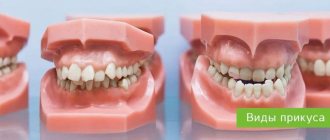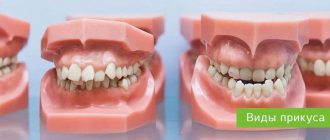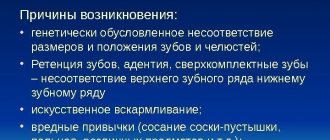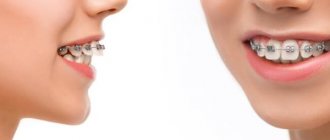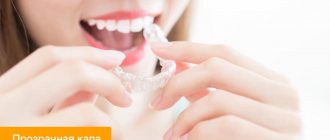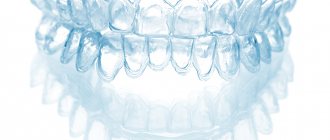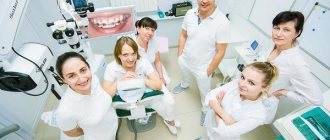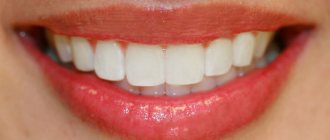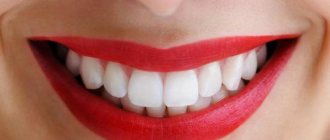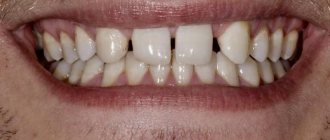How a bite is formed What a correct bite looks like Types Definition of a bite Possible consequences Methods of correction
Teeth bite is the relative arrangement of the dentition when the jaws are completely closed.
The formation of the dental system begins in intrauterine development. By the 11th week, the fetus has jaw stripes. Almost all children are born with malocclusion. The lower jaw is moved back. Dentists call this phenomenon retrognathia. When a baby actively sucks, the muscles are trained. By 6-8 months with breastfeeding, and a little later, with artificial feeding, the lower jaw takes the correct position. For bottle-fed children, it is necessary to monitor the position of the body and the hole in the nipple. If the formula does not flow from the bottle, you have to make an effort to get it, the child’s tongue and jaw muscles receive sufficient stress and malocclusions can be avoided.
Stages of bite formation
The first stage is completed by the time teeth erupt. Then it is formed:
- Temporary bite
Period: from 6 months to 3 years
. Teeth are actively growing, their relationship in the jaw is changing. When all the teeth have erupted, the stage of a formed temporary bite begins. It lasts until the moment when baby teeth begin to be replaced by permanent ones. The number of teeth is 20. Their location is influenced by the child’s habits: thumb sucking, sucking a corner of a bedspread, long-term use of a pacifier. Most causes of pathologies appear at this age.
- Replaceable (mixed)
Period: 6-14 years
. The active growth of permanent teeth increases the bite and promotes changes in the position of the jaw relative to each other. The jaws are in the process of formation. This is the ideal time for orthodontic treatment.
- Constant
Once all the baby teeth have fallen out, the bite becomes permanent. Number of teeth 28-32. With the appearance of fangs, the bite increases again.
The final formation of the jaws is completed by the age of 21, but the movement of teeth continues throughout life. The teeth are worn down by the friction of the side parts, because of this their position in the jaw changes, although we do not notice it. Dentists call this process mesial movement.
V PERIOD - from 6 to 9 years (initial period of mixed dentition)
Prevention and treatment of dental anomalies:
- detection of malocclusions and their orthodontic treatment
- planned sanitation of the oral cavity and regular hygiene using special-purpose products
- observation of the sequence of eruption of the first permanent molars, incisors and massage of the alveolar process
- selective grinding of unworn cusps of temporary teeth (usually canines)
- plastic surgery of a shortened or improperly attached frenulum of the tongue
- plastic surgery of a shortened or improperly attached frenulum of the upper or lower lip (if there is a diastema, three)
- removal of retained primary incisors and erupted supernumerary teeth
- identification of postural disorders, flat feet, therapeutic exercises and orthopedic consultation
- fighting bad habits of sucking and biting fingers, lips, cheeks, tongue, various objects, with habitual incorrect posture
- detection of nasal breathing disorders. Consultation with an ENT doctor. Sanitation of ENT organs. Removal of adenoids and velopharyngeal tonsils for orthodontic indications in cases of severe malocclusion
- the use of therapeutic exercises to normalize nasal breathing, swallowing, and posture
- training from a speech therapist in the correct pronunciation of individual sound phonemes
- early removal of the buds of 3 molars (wisdom teeth) at the age of 7 years
What does a correct teeth bite look like?
Physiological (correct) occlusion in humans is characterized by:
- adequate form of dentition. The top one looks like a semi-ellipse, the bottom one resembles a parabola;
- the upper incisors overlap the lower ones by ⅓ of the height;
- there is contact between all teeth;
- the lower teeth are vertical, the upper teeth are inclined;
- each tooth, except 4, has 2 antagonists (one opposite);
- the correct bite in the diagram is marked by the symmetry of the incisors;
- chewing teeth are in contact with each other.
Correct bite in adults has its own variations. All of them are considered a variant of the norm:
- Orthognathic
. The upper teeth slightly overlap the lower teeth, and all molars and premolars occlude. - Straight
. The upper teeth do not overlap the lower ones, but join with them. The lateral teeth meet well. - Physiological progeny
. The lower teeth protrude beyond the upper teeth, but contact is maintained. The lateral teeth close together without gaps. - Biprognathic
. The incisors of both jaws are inclined forward, with intact contact.
Types and features of bracket systems
In the past, there were only metal braces - they were not aesthetically pleasing and caused some inconvenience. Today, a huge number of other devices are used for constant wear, and braces have become much more comfortable and aesthetically pleasing.
There are three classifications of systems, which are based on the installation method, mounting location, and material.
Types of braces according to the method of arch attachment
For adult patients, two types of stationary systems are used: ligature and self-ligating (ligature-free). To better understand how they differ from each other, you need to have a good understanding of the design of braces.
Braces consist of an arch and clasps that are located on the teeth. In ligature systems, the clasps are attached to the arch using special rings - ligatures. In self-ligating rings, such rings are not used - the arcs are inserted into a special groove.
Ligature braces
Ligature bracket systems have a classic design and have proven their effectiveness in various pathologies. They will ensure the correction of the bite in the shortest possible time, if we are talking about a relatively strong displacement of the teeth.
Such systems also have a drawback: the patient will have to come to the orthodontist every month for correction.
Self-ligating systems
Ligature-free braces have two key advantages: they are much more aesthetically pleasing and save the patient’s time. You will have to visit the orthodontist every one and a half to two months, and not monthly, as is the case with ligatures.
There is another advantage: such braces provide gentle but constant pressure on the teeth.
Types of braces according to installation site
Classic braces have always been installed on the outside of the teeth. However, in recent years, systems have appeared that can also be worn from the inside. Let's take a closer look at each type.
Vestibular (external) bracket systems
This is a classic version of the system: such braces are located on the outside of the dentition and are visible from the outside. Despite some damage to aesthetics, they are chosen most often due to their high efficiency and relatively low cost.
Lingual systems
Lingual or internal braces are much more aesthetically pleasing. They are simply not visible from the outside: all elements of the system are located on the back side of the dentition.
Lingual systems are more expensive and require some getting used to: they affect diction. However, if you work with people all the time, have a slight malocclusion, and don't want others to see your braces, you can use this option.
Types of braces by material
Once upon a time, only metal braces were available, and many who wanted to correct their bite were embarrassed to go to the orthodontist and wear braces for several years. The situation has changed: now the range of braces has expanded, and they began to be made from different materials - from traditional metal to ceramics and even sapphires. The appearance of the systems has also changed - now they look much more aesthetically pleasing and even look like decoration.
Metal bracket systems
These are inexpensive, fairly effective and reliable systems that have gained maximum popularity. Most often, such braces are made of medical steel - it does not cause irritation or allergies, and does not react with saliva and acids that may be in the oral cavity.
In addition to steel systems, titanium systems are used - the most durable and eliminate any reaction in the oral cavity, as well as gold. Gold braces are aesthetically pleasing and effective.
Plastic braces
This is the first type of system to appear as an alternative to metal braces. Plastic systems are aesthetic, almost invisible on the teeth, and are inexpensive. They also have disadvantages: low strength and the possibility of coloring. The first can be eliminated only by completely changing braces, the second can be eliminated by choosing colored systems.
Ceramic braces
Ceramic onlays on the teeth are difficult to notice and provide a good hold. However, like plastic ones, they can collapse under mechanical stress. Coloring is also possible - after strong tea, coffee, cherry juice, red wine.
Sapphire braces
Such systems are made from aluminum oxide. They are almost invisible on the teeth, and in terms of strength they are comparable to ceramic braces. Unfortunately, they also have a drawback - high cost.
Combined bracket systems
Doctors often choose combined braces. They combine the aesthetic appearance of ceramic structures (on the visible upper jaw row) and the strength of metal ones. Also, such designs are relevant if you need to create different tension on the teeth.
Plus this is due to:
- reasonable price for the patient;
- effective and short-term treatment;
- ability to correct complex cases.
Other types of occlusion in dentistry
There are 3 large groups of bites.
- Normal
(physiological). These bites have several variations, but the teeth are closed, the jaws are in the correct position, and the teeth are symmetrical along the incisors. - Anomalous
. Congenital defects caused by harmful effects on the fetus during pregnancy or genetic disorders - Pathological
. Defects acquired after teething as a result of disease, missing units, or displacement of teeth.
In life, the last two concepts are often mixed and replace each other. Based on the relationship between teeth and jaws, the following types of bite are distinguished:
Deep
The upper teeth cover the upper ones by more than ⅓. The contact between the teeth is broken. This leads to impaired chewing function, abnormal enlargement of the upper jaw, and disruption of the anatomical structure of the face. The second name for this defect is traumatic. As a result of pathology, the functioning of the temporomandibular joint is often disrupted, the mucous membranes are injured, and the enamel is pathologically erased. This is the most common pathology.
Open
The teeth do not close completely. The defect can be frontal or lateral. This pathology is characterized by impaired diction, chewing, and swallowing. Mouth breathing is observed, hence drying out of the mucous membrane and frequent caries.
Distal
With this defect, the upper jaw is strongly pushed forward. The front teeth do not occlude, and the occlusion of the rear teeth is broken. Characterized by problems with breathing, chewing, and swallowing. Patients complain of joint pain, frequent caries, and periodontal disease.
Mesial
When the lower jaw is pushed forward, they speak of progeny or mesial occlusion. This jaw bite pathology is accompanied by diastemas (large gaps between the front teeth) or trema (gaps between any teeth). Often patients have crooked lower teeth, they are crowded, and there is increased deposit of tartar.
Crossbite
Some units overlap each other. Difficult to treat, surgical intervention is often used. It is characterized by facial deformation, speech defects, disruption of chewing function and the functioning of the TMJ. Patients complain of constant biting of the cheeks and tongue.
All pathological forms of bites in orthodontics are recommended for correction with removable (for baby teeth) and non-removable structures (braces), and aligners.
Causes of pathological bite
There are many reasons for malocclusion. In most cases they are the same for children and adults. A harmful myofunctional habit such as a love of chewing a pencil and many other factors can serve as an impetus for the appearance of disorders.
There is an opinion that dental malocclusion occurs only in children, but it is erroneous. Birth defects usually appear in childhood. In adults, changes are often associated with injuries, unhealthy lifestyles, and advanced diseases of teeth and gums.
In children
The causes of incorrect jaw position and abnormal development of teeth in a child can be called:
- injuries that the baby received during childbirth, if there were complications;
- poor heredity and genetic tendency to an irregular jaw shape;
- malnutrition of the fetus during pregnancy, which may be associated with a woman’s illness;
- the formation of mouth breathing, which not only moves the teeth, but also prevents the nasal sinuses from fully developing;
- Incorrect positioning of the baby during breastfeeding or bottle feeding;
- love for prolonged sucking of collars, fingers, toys, abuse of pacifiers;
- rickets or disruptions in the body’s metabolic processes, as well as poor nutrition, lack of food with fluoride and calcium;
- incorrect position during sleep, thumb sucking during sleep;
- delayed replacement of temporary teeth with molars and too early start of teeth change.
In adults
The appearance of malocclusion in an adult is almost always associated with one or more reasons from the following list:
- chronic diseases of the nasopharynx, especially affected by constant nasal congestion;
- multiple carious lesions of teeth, in which a person incorrectly distributes the load on the jaws;
- improper and poor nutrition due to which the teeth do not receive the necessary vitamins and minerals to restore the protective layer of enamel, as well as metabolic failures in which the body cannot extract the necessary microelements from food. The lack of fluoride and calcium has a particularly negative effect;
- injuries of the dental system, etc.
Determination of dental occlusion
Often problems with bite are obvious, but it also happens that everything looks normal on the outside, but there is a problem. Therefore, it is better to entrust the determination of the bite to the dentist. They use special methods to determine correct or incorrect bite and prescribe treatment.
Diagnostics include:
- Clinical examination
The orthodontist collects anamnesis, conducts a general examination and examines the oral cavity and nasopharynx. They examine breathing, speech formation, swallowing, chewing, biting.
- X-ray examination
A panoramic X-ray or CT scan allows you to identify skeletal abnormalities, see the exact location of the teeth, the condition of the roots, and bone tissue.
- Biometric test
The doctor examines the jaws, takes and records all measurements.
- Functional test
Examination in a stationary position, while talking, opening the mouth in the lateral and frontal projection.
It is impossible to put the jaw back in place on your own, but the sooner the intervention begins, the better the result. It is very difficult to restore the correct position of teeth after 25 years; it is better to do this while the bite is forming.
VIII PERIOD - from 15 to 21 years (completion of the formation of permanent dentition)
Prevention and treatment of dental anomalies:
- sanitation of the oral cavity, hygiene, use of individual care and prevention products
- mandatory professional hygiene
- observation by a periodontist, consultation and treatment of periodontal diseases
- identification of dental anomalies and their orthodontic treatment
- introduction to food hygiene
- elimination of calcium deficiency
- restoration of crowns of damaged teeth
- restoration of bite height, alignment of occlusion, selective grinding of teeth
- timely prosthetics
- monitoring the eruption of 3 molars (wisdom teeth) and their timely removal
- identification of incorrect habitual postures, posture disorders,
- prevention and treatment of osteochondrosis
- sports, fitness, swimming
- eliminating risk factors
- formation of useful habits and skills
- surgical treatment of severe deformities of the maxillofacial area
Consequences
The influence of bite on the condition of the dental system and the entire body is enormous.
Bite pathologies lead to:
- Loss of teeth. Uneven chewing load leads to cracks and chips. Bacteria penetrate through the damaged enamel layer, affecting periodontal tissue. Periodontitis develops. Teeth become loose and fall out. The risk of caries in such cases is higher than in people without defects.
- Disorders of the temporomandibular joint (TMJ). It begins to click, hurt, and in severe cases, dislocation is possible.
- Due to crowded teeth, plaque and tartar quickly form, which provokes gingivitis and periodontitis.
- Insufficient contact between teeth leads to food being poorly chewed. As a result, problems arise with the gastrointestinal tract.
- Oral, impaired breathing causes diseases of the respiratory system.
- The position of the jaws affects posture. An abnormal movement of the jaw forward shifts the center of gravity, the position of the neck changes, the chest collapses, and the person begins to stoop. Muscle tone is impaired and back pain begins.
- An incorrect bite distorts facial features and disrupts its symmetry.
Anomalies of the jaws affect the psychological state. The person withdraws into himself and avoids company. Depressive states are common.
Orthodontic treatment restores physical and emotional balance and helps improve self-esteem.
VII PERIOD - from 12 to 15 years (period of formation of permanent dentition)
Prevention and treatment of dental anomalies:
- identification of dental anomalies and their orthodontic treatment
- planned sanitation of the oral cavity, mandatory consultation with a periodontist to identify periodontal diseases and their treatment
- oral hygiene training, individual selection of hygiene and prevention products
- identification of postural disorders, flat feet, torticollis, therapeutic exercises and consultation with an orthopedist. Swimming, fitness classes
- identification of gastrointestinal dysfunctions, introduction to food hygiene, consultation with a therapist
- identification and elimination of calcium deficiency
- determination of skeletal ossification disorders and consultation with an endocrinologist
- introduction to risk factors
The cost of braces: a brief overview
Of course, it is impossible to give exact prices at the moment: the cost of all braces, as well as dental services, is gradually increasing. In addition, the final amount depends on the condition of the teeth and the final design of the braces. But general information can be provided.
The most affordable braces systems are classic ones, which are classified as ligature, are installed on the outside of the teeth and are made of medical steel. Their cost ranges from several thousand rubles. Plastic systems of the same type cost approximately the same.
Ceramic ones will be more expensive - the bill will already be several tens of thousands of rubles. Sapphire ones will be slightly more expensive. Titanium and gold cost even more due to high prices for materials.
However, the cost is affected not only by the material from which the braces are made. In particular, you will have to spend at least 40 thousand rubles on non-ligature systems, even if they are created from ordinary medical steel. The reason is a more complex design and high requirements for the product. The same applies to lingual systems: they must be much smaller, but must provide the same fixation and pressure as conventional vestibular braces. Their cost can exceed 100 thousand rubles.
More accurate information on prices can be found by going to the price list section, or by contacting our manager by phone.
